Novel Image State Ensemble Decomposition Method for M87 Imaging
Abstract
1. Introduction
2. Materials and Methods
3. Mathematics of ψ Image State Ensembles
3.1. ψ Color Channel Relations
3.2. Generalized ψ Image State Ensemble Constitutive Relationships for N-wavelength λ
3.3. ψ Ensemble Matrices for ϕn = [0,1], αn = βn = 1
3.4. Image State Ensemble Decomposition
3.5. Simplified Image States Ensemble Decomposition
3.6. Generalized Image States Ensemble for N-Dimensions
3.7. Balanced Image State Ensemble Decomposition for RGB
4. Results and Discussion
| Algorithm 1 ISED Generation |
| 1: Load the input image. |
| 2: Separate the image into its color channels R’, G’, and B’ in RGB color space. |
| 3: Use Equation (3) is used to build the filters for ψ R, ψ G, and ψ B. . |
| 4: Set the [0,1] state conditions from Appendix A, for ψ1, ψ2, ψ3, ψ4, ψ5, ψ6. This defines the state ensemble conditions. 5: The ISED color channel filter is for ψ R, ψ G, and ψ B. The combination of ψ R, ψ G, and ψ B would produce the ISED filter image. An example of an ISED filter image is shown in Figure 2c. |
| 6: Applying Equation (5) forms the modified Rn, Gn, and Bn color channels. These channels are used to build the ISED Image. |
| 7: Recombine the color channels to form a newly generated ISED image in (RGB)n. 8: Output the ISED image 9: Optional Output the ISED filter image. Original image – ISED image = ISED filter image or equivalently combine recombine the color channels from ψ R, ψ G, and ψ B to build ψ(RGB). |
5. Conclusions
Supplementary Materials
Author Contributions
Funding
Acknowledgments
Conflicts of Interest
Appendix A
| State | Switch | ψ1 | ψ2 | ψ3 | ψ4 | ψ5 | ψ6 |
|---|---|---|---|---|---|---|---|
| 0 | (RGB)n | 0 | 0 | 0 | 0 | 0 | 0 |
| 1 | (RGB)n | 0 | 0 | 0 | 0 | 0 | 1 |
| 2 | (RGB)n | 0 | 0 | 0 | 0 | 1 | 0 |
| 3 | (RGB)n | 0 | 0 | 0 | 0 | 1 | 1 |
| 4 | (RGB)n | 0 | 0 | 0 | 1 | 0 | 0 |
| 5 | (RGB)n | 0 | 0 | 0 | 1 | 0 | 1 |
| 6 | (RGB)n | 0 | 0 | 0 | 1 | 1 | 0 |
| 7 | (RGB)n | 0 | 0 | 0 | 1 | 1 | 1 |
| 8 | (RGB)n | 0 | 0 | 1 | 0 | 0 | 0 |
| 9 | (RGB)n | 0 | 0 | 1 | 0 | 0 | 1 |
| 10 | (RGB)n | 0 | 0 | 1 | 0 | 1 | 0 |
| 11 | (RGB)n | 0 | 0 | 1 | 0 | 1 | 1 |
| 12 | (RGB)n | 0 | 0 | 1 | 1 | 0 | 0 |
| 13 | (RGB)n | 0 | 0 | 1 | 1 | 0 | 1 |
| 14 | (RGB)n | 0 | 0 | 1 | 1 | 1 | 0 |
| 15 | (RGB)n | 0 | 0 | 1 | 1 | 1 | 1 |
| 16 | (RGB)n | 0 | 1 | 0 | 0 | 0 | 0 |
| 17 | (RGB)n | 0 | 1 | 0 | 0 | 0 | 1 |
| 18 | (RGB)n | 0 | 1 | 0 | 0 | 1 | 0 |
| 19 | (RGB)n | 0 | 1 | 0 | 0 | 1 | 1 |
| 20 | (RGB)n | 0 | 1 | 0 | 1 | 0 | 0 |
| 21 | (RGB)n | 0 | 1 | 0 | 1 | 0 | 1 |
| 22 | (RGB)n | 0 | 1 | 0 | 1 | 1 | 0 |
| 23 | (RGB)n | 0 | 1 | 0 | 1 | 1 | 1 |
| 24 | (RGB)n | 0 | 1 | 1 | 0 | 0 | 0 |
| 25 | (RGB)n | 0 | 1 | 1 | 0 | 0 | 1 |
| 26 | (RGB)n | 0 | 1 | 1 | 0 | 1 | 0 |
| 27 | (RGB)n | 0 | 1 | 1 | 0 | 1 | 1 |
| 28 | (RGB)n | 0 | 1 | 1 | 1 | 0 | 0 |
| 29 | (RGB)n | 0 | 1 | 1 | 1 | 0 | 1 |
| 30 | (RGB)n | 0 | 1 | 1 | 1 | 1 | 0 |
| 31 | (RGB)n | 0 | 1 | 1 | 1 | 1 | 1 |
| 32 | (RGB)n | 1 | 0 | 0 | 0 | 0 | 0 |
| 33 | (RGB)n | 1 | 0 | 0 | 0 | 0 | 1 |
| 34 | (RGB)n | 1 | 0 | 0 | 0 | 1 | 0 |
| 35 | (RGB)n | 1 | 0 | 0 | 0 | 1 | 1 |
| 36 | (RGB)n | 1 | 0 | 0 | 1 | 0 | 0 |
| 37 | (RGB)n | 1 | 0 | 0 | 1 | 0 | 1 |
| 38 | (RGB)n | 1 | 0 | 0 | 1 | 1 | 0 |
| 39 | (RGB)n | 1 | 0 | 0 | 1 | 1 | 1 |
| 40 | (RGB)n | 1 | 0 | 1 | 0 | 0 | 0 |
| 41 | (RGB)n | 1 | 0 | 1 | 0 | 0 | 1 |
| 42 | (RGB)n | 1 | 0 | 1 | 0 | 1 | 0 |
| 43 | (RGB)n | 1 | 0 | 1 | 0 | 1 | 1 |
| 44 | (RGB)n | 1 | 0 | 1 | 1 | 0 | 0 |
| 45 | (RGB)n | 1 | 0 | 1 | 1 | 0 | 1 |
| 46 | (RGB)n | 1 | 0 | 1 | 1 | 1 | 0 |
| 47 | (RGB)n | 1 | 0 | 1 | 1 | 1 | 1 |
| 48 | (RGB)n | 1 | 1 | 0 | 0 | 0 | 0 |
| 49 | (RGB)n | 1 | 1 | 0 | 0 | 0 | 1 |
| 50 | (RGB)n | 1 | 1 | 0 | 0 | 1 | 0 |
| 51 | (RGB)n | 1 | 1 | 0 | 0 | 1 | 1 |
| 52 | (RGB)n | 1 | 1 | 0 | 1 | 0 | 0 |
| 53 | (RGB)n | 1 | 1 | 0 | 1 | 0 | 1 |
| 54 | (RGB)n | 1 | 1 | 0 | 1 | 1 | 0 |
| 55 | (RGB)n | 1 | 1 | 0 | 1 | 1 | 1 |
| 56 | (RGB)n | 1 | 1 | 1 | 0 | 0 | 0 |
| 57 | (RGB)n | 1 | 1 | 1 | 0 | 0 | 1 |
| 58 | (RGB)n | 1 | 1 | 1 | 0 | 1 | 0 |
| 59 | (RGB)n | 1 | 1 | 1 | 0 | 1 | 1 |
| 60 | (RGB)n | 1 | 1 | 1 | 1 | 0 | 0 |
| 61 | (RGB)n | 1 | 1 | 1 | 1 | 0 | 1 |
| 62 | (RGB)n | 1 | 1 | 1 | 1 | 1 | 0 |
Appendix B
| M87 | full-size | cropped | full-size | cropped | full-size | cropped |
|---|---|---|---|---|---|---|
| IQA | SSIM | SSIM | IMMSE | IMMSE | PSNR | PSNR |
| State 1 | 0.7249 | 0.7456 | 284.6252 | 306.8651 | 23.5881 | 23.2613 |
| State 2 | 0.8221 | 0.8974 | 156.2647 | 124.0544 | 26.1922 | 27.1947 |
| State 3 | 0.5578 | 0.4641 | 533.5547 | 687.4574 | 20.859 | 19.7583 |
| State 4 | 0.9729 | 0.9998 | 2.2677 | 4.7465 | 44.5749 | 41.3671 |
| State 5 | 0.6792 | 0.7455 | 289.3453 | 311.6121 | 23.5166 | 23.1947 |
| State 6 | 0.7872 | 0.8972 | 161.0807 | 128.8018 | 26.0604 | 27.0316 |
| State 7 | 0.5376 | 0.4639 | 535.4512 | 692.2054 | 20.8436 | 19.7285 |
| State 8 | 0.9784 | 0.9934 | 2.4546 | 72.9233 | 44.231 | 29.5021 |
| State 9 | 0.7023 | 0.7392 | 287.0798 | 379.7883 | 23.5508 | 22.3354 |
| State 10 | 0.7973 | 0.8908 | 158.7745 | 196.9777 | 26.123 | 25.1866 |
| State 11 | 0.5324 | 0.4577 | 536.0645 | 760.3807 | 20.8386 | 19.3205 |
| State 12 | 0.9456 | 0.9914 | 5.1524 | 105.9679 | 41.0107 | 27.8791 |
| State 13 | 0.6512 | 0.7372 | 292.23 | 412.8335 | 23.4736 | 21.9731 |
| State 14 | 0.7602 | 0.8887 | 163.9132 | 230.0232 | 25.9847 | 24.5131 |
| State 15 | 0.5102 | 0.4557 | 538.2837 | 793.4268 | 20.8207 | 19.1357 |
| State 16 | 0.9813 | 0.9941 | 2.924 | 51.6947 | 43.471 | 30.9963 |
| State 17 | 0.7033 | 0.7405 | 287.8371 | 358.7106 | 23.5393 | 22.5834 |
| State 18 | 0.801 | 0.8916 | 159.1888 | 175.749 | 26.1117 | 25.6819 |
| State 19 | 0.5343 | 0.459 | 536.7666 | 739.3029 | 20.8329 | 19.4426 |
| State 20 | 0.9487 | 0.9925 | 5.4492 | 77.3082 | 40.7675 | 29.2485 |
| State 21 | 0.6523 | 0.7389 | 292.8146 | 384.3246 | 23.4649 | 22.2838 |
| State 22 | 0.7619 | 0.89 | 164.2622 | 201.3634 | 25.9754 | 25.091 |
| State 23 | 0.51 | 0.4575 | 538.9205 | 764.9179 | 20.8156 | 19.2947 |
| State 24 | 0.9564 | 0.9772 | 7.0676 | 203.4258 | 39.6381 | 25.0467 |
| State 25 | 0.6777 | 0.7237 | 291.9807 | 510.4417 | 23.4773 | 21.0513 |
| State 26 | 0.7739 | 0.8747 | 163.3874 | 327.4802 | 25.9986 | 22.979 |
| State 27 | 0.507 | 0.4423 | 540.9653 | 891.0341 | 20.7991 | 18.6319 |
| State 28 | 0.9269 | 0.9751 | 9.495 | 238.2591 | 38.3558 | 24.3603 |
| State 29 | 0.6301 | 0.7216 | 296.8605 | 545.2755 | 23.4053 | 20.7646 |
| State 30 | 0.7409 | 0.8726 | 168.2559 | 362.3143 | 25.8711 | 22.5399 |
| State 31 | 0.489 | 0.4402 | 542.9142 | 925.8688 | 20.7835 | 18.4653 |
| State 32 | 0.946 | 0.9663 | 31.3918 | 50.5701 | 33.1626 | 31.0919 |
| State 33 | 0.6243 | 0.5649 | 417.3726 | 546.6504 | 21.9256 | 20.7537 |
| State 34 | 0.679 | 0.7458 | 289.8595 | 307.8813 | 23.5089 | 23.247 |
| State 35 | 0.528 | 0.3311 | 592.8357 | 931.8355 | 20.4015 | 18.4374 |
| State 36 | 0.9156 | 0.9661 | 33.6595 | 55.3166 | 32.8597 | 30.7022 |
| State 37 | 0.5778 | 0.5648 | 422.0927 | 551.3974 | 21.8767 | 20.7162 |
| State 38 | 0.6434 | 0.7456 | 294.6755 | 312.6287 | 23.4374 | 23.1805 |
| State 39 | 0.5076 | 0.331 | 594.7321 | 936.5834 | 20.3876 | 18.4153 |
| State 40 | 0.9224 | 0.9594 | 34.2917 | 127.0134 | 32.7789 | 27.0923 |
| State 41 | 0.6 | 0.5582 | 420.2725 | 623.0936 | 21.8955 | 20.1853 |
| State 42 | 0.6523 | 0.7389 | 292.8146 | 384.3246 | 23.4649 | 22.2838 |
| State 43 | 0.501 | 0.3244 | 595.7907 | 1008.3 | 20.3799 | 18.095 |
| State 44 | 0.8865 | 0.9573 | 36.9895 | 160.058 | 32.45 | 26.088 |
| State 45 | 0.5482 | 0.5562 | 425.4227 | 656.1388 | 21.8426 | 19.9608 |
| State 46 | 0.6146 | 0.7369 | 297.9534 | 417.3701 | 23.3893 | 21.9256 |
| State 47 | 0.4787 | 0.3224 | 598.01 | 1041.3 | 20.3637 | 17.9549 |
| State 48 | 0.9231 | 0.9596 | 35.5677 | 107.6815 | 32.6202 | 27.8094 |
| State 49 | 0.6028 | 0.559 | 421.4488 | 603.9357 | 21.8834 | 20.3209 |
| State 50 | 0.6541 | 0.7392 | 294.0355 | 364.9927 | 23.4468 | 22.508 |
| State 51 | 0.505 | 0.3252 | 596.9118 | 989.1208 | 20.3717 | 18.1783 |
| State 52 | 0.8874 | 0.958 | 38.0928 | 133.295 | 32.3224 | 26.8827 |
| State 53 | 0.5512 | 0.5574 | 426.4263 | 629.5497 | 21.8324 | 20.1405 |
| State 54 | 0.6144 | 0.7376 | 299.1089 | 390.6071 | 23.3725 | 22.2134 |
| State 55 | 0.4806 | 0.3236 | 599.0657 | 1014.7 | 20.3561 | 18.0673 |
| State 56 | 0.8991 | 0.9425 | 39.6904 | 260.6952 | 32.1439 | 23.9695 |
| State 57 | 0.5783 | 0.542 | 425.5715 | 756.9494 | 21.8411 | 19.3401 |
| State 58 | 0.628 | 0.7222 | 298.2133 | 518.0064 | 23.3855 | 20.9875 |
| State 59 | 0.479 | 0.3083 | 601.0897 | 1142.1 | 20.3414 | 17.5536 |
| State 60 | 0.8667 | 0.9404 | 42.1179 | 295.5284 | 31.8861 | 23.4248 |
| State 61 | 0.5304 | 0.5399 | 430.4513 | 791.7831 | 21.7916 | 19.1447 |
| State 62 | 0.5947 | 0.7201 | 303.0817 | 552.8405 | 23.3152 | 20.7048 |
| State 63 | 0.461 | 0.3062 | 603.0385 | 1177 | 20.3274 | 17.4232 |
| Average | 0.689448 | 0.700152 | 298.2176 | 473.0918 | 26.0371 | 22.83558 |
Appendix C
| M87 | full-size | cropped | full-size | cropped | full-size | cropped |
|---|---|---|---|---|---|---|
| IQA | NIQE | NIQE | BRISQUE | BRISQUE | PIQE | PIQE |
| Original (0) | 5.5439 | 8.221 | 43.5626 | 43.3802 | 57.3674 | 100 |
| State 1 | 5.1525 | 6.8515 | 50.5449 | 44.2074 | 65.4678 | 47.8352 |
| State 2 | 5.7916 | 6.5504 | 52.7102 | 44.215 | 58.4882 | 57.7265 |
| State 3 | 6.4111 | 7.0434 | 50.7603 | 38.6581 | 63.7614 | 47.9279 |
| State 4 | 5.248 | 8.4311 | 42.3581 | 43.3943 | 44.6338 | 100 |
| State 5 | 5.2352 | 6.9755 | 48.9766 | 44.2729 | 64.315 | 47.8352 |
| State 6 | 5.32 | 6.5772 | 44.1291 | 44.025 | 58.1427 | 57.7265 |
| State 7 | 7.3535 | 7.0815 | 46.8573 | 38.4746 | 64.4827 | 47.9279 |
| State 8 | 5.3848 | 8.5668 | 43.6858 | 43.4027 | 55.6351 | 61.4009 |
| State 9 | 5.2082 | 7.5941 | 49.7429 | 45.6238 | 66.8966 | 47.7678 |
| State 10 | 5.2968 | 6.3655 | 51.5852 | 45.0842 | 57.0669 | 57.3051 |
| State 11 | 6.1516 | 7.0329 | 50.3401 | 38.9643 | 72.8547 | 47.871 |
| State 12 | 5.0405 | 9.0827 | 44.2146 | 43.4156 | 44.798 | 30.8029 |
| State 13 | 4.9928 | 7.8486 | 46.5314 | 46.0398 | 66.2953 | 46.5858 |
| State 14 | 5.0882 | 6.4732 | 50.9033 | 45.5357 | 57.588 | 50.2252 |
| State 15 | 7.6073 | 7.1537 | 45.4138 | 39.1938 | 71.734 | 46.8976 |
| State 16 | 5.3189 | 7.9185 | 43.2691 | 43.3711 | 56.0633 | 21.7746 |
| State 17 | 5.2147 | 7.1367 | 50.3004 | 44.8827 | 68.3096 | 45.588 |
| State 18 | 5.0877 | 6.3235 | 50.6286 | 46.0113 | 61.9339 | 45.6796 |
| State 19 | 6.3632 | 6.8149 | 50.381 | 38.2344 | 75.2535 | 46.1974 |
| State 20 | 4.9809 | 7.9336 | 43.7264 | 43.3744 | 46.701 | 27.6346 |
| State 21 | 5.0113 | 7.135 | 46.9884 | 44.8816 | 69.0178 | 45.5953 |
| State 22 | 5.0051 | 6.2988 | 52.2023 | 45.8963 | 59.7526 | 47.7231 |
| State 23 | 7.7204 | 6.7622 | 45.5546 | 38.0993 | 72.4522 | 46.2034 |
| State 24 | 5.1939 | 7.7798 | 42.6634 | 43.3795 | 57.7926 | 16.4117 |
| State 25 | 5.2773 | 7.2776 | 47.2636 | 45.8317 | 70.7779 | 45.7809 |
| State 26 | 4.9438 | 6.283 | 48.1169 | 46.4452 | 61.9583 | 45.1058 |
| State 27 | 6.3725 | 6.8706 | 49.2368 | 39.5769 | 75.2643 | 46.2315 |
| State 28 | 4.7734 | 7.9567 | 42.573 | 43.3881 | 48.9754 | 26.9581 |
| State 29 | 5.0337 | 7.4362 | 47.7704 | 45.9332 | 70.9652 | 46.5734 |
| State 30 | 4.9093 | 6.3134 | 49.9425 | 46.4059 | 60.0145 | 48.1446 |
| State 31 | 7.7791 | 6.9571 | 44.99 | 39.5976 | 72.8358 | 46.8851 |
| State 32 | 5.396 | 7.554 | 40.0833 | 40.7535 | 57.1412 | 49.3256 |
| State 33 | 4.975 | 7.1325 | 48.4586 | 38.9923 | 67.3844 | 46.1528 |
| State 34 | 5.24 | 6.8071 | 48.9712 | 44.1932 | 66.4844 | 46.7781 |
| State 35 | 6.5276 | 6.6815 | 48.607 | 45.2063 | 57.92 | 45.9668 |
| State 36 | 4.6622 | 7.6449 | 36.3049 | 40.3969 | 51.0752 | 49.3256 |
| State 37 | 5.256 | 7.0666 | 47.0479 | 39.4507 | 65.1939 | 46.1528 |
| State 38 | 5.2697 | 6.8197 | 50.0249 | 44.2262 | 72.371 | 46.7781 |
| State 39 | 7.8122 | 6.5803 | 45.749 | 45.014 | 57.4626 | 45.9668 |
| State 40 | 5.3656 | 8.3644 | 39.1155 | 40.0945 | 57.6231 | 48.6578 |
| State 41 | 5.1239 | 7.2358 | 50.7715 | 39.8505 | 69.2868 | 45.9173 |
| State 42 | 5.0113 | 7.135 | 46.9884 | 44.8816 | 69.0178 | 45.5953 |
| State 43 | 6.4068 | 6.7588 | 48.3767 | 45.3548 | 63.4619 | 45.635 |
| State 44 | 4.6366 | 8.8306 | 39.143 | 40.251 | 51.6093 | 48.2022 |
| State 45 | 5.2678 | 7.3257 | 44.6537 | 40.0555 | 67.1369 | 45.5516 |
| State 46 | 5.2025 | 7.3574 | 48.3003 | 45.5488 | 73.1923 | 44.3819 |
| State 47 | 8.3998 | 6.7453 | 44.9609 | 45.4404 | 59.5353 | 44.9559 |
| State 48 | 5.3462 | 8.1481 | 39.5779 | 40.0773 | 58.6466 | 47.5028 |
| State 49 | 5.0777 | 7.1313 | 49.8544 | 39.7335 | 69.4 | 44.8174 |
| State 50 | 5.0838 | 7.2898 | 46.8529 | 45.4694 | 71.3228 | 43.3041 |
| State 51 | 6.5747 | 6.7488 | 48.4272 | 45.0835 | 67.7667 | 44.2724 |
| State 52 | 4.6214 | 8.1002 | 38.777 | 39.9674 | 52.4489 | 47.4394 |
| State 53 | 5.316 | 6.9881 | 45.1495 | 39.8576 | 66.4963 | 44.9148 |
| State 54 | 5.1681 | 7.1605 | 49.7209 | 45.5227 | 74.0599 | 43.3186 |
| State 55 | 8.3876 | 6.5833 | 45.1085 | 44.95 | 62.0371 | 44.454 |
| State 56 | 5.2763 | 7.9737 | 39.229 | 40.0887 | 59.4569 | 47.7576 |
| State 57 | 5.254 | 7.2237 | 51.2977 | 39.7388 | 71.2543 | 44.6351 |
| State 58 | 5.072 | 7.0904 | 47.4178 | 45.501 | 71.8698 | 43.3825 |
| State 59 | 6.7407 | 6.722 | 48.2777 | 45.5848 | 65.7914 | 44.0943 |
| State 60 | 4.5445 | 8.0195 | 39.0258 | 40.0283 | 53.2504 | 48.1036 |
| State 61 | 5.4902 | 7.2479 | 44.1724 | 39.7898 | 67.779 | 45.1196 |
| State 62 | 5.1631 | 7.1282 | 47.6513 | 45.5478 | 74.2789 | 44.6331 |
| State 63 | 8.5556 | 6.7111 | 44.5938 | 45.5534 | 59.823 | 45.0998 |
References
- Gonzalez, R.; Woods, R. Digital Image Processing, 2nd ed.; Prentice Hall: Upper Saddle River, NJ, USA, 2002; p. 793. [Google Scholar]
- Land, E.H.; McCann, J. Lightness and retinex theory. J. Opt. Soc. Am. 1971, 61, 2032–2040. [Google Scholar] [CrossRef] [PubMed]
- Reinhard, E. High Dynamic Range Imaging: Acquisition, Display, and Image-Based Lighting; Morgan Kaufmann: Burlington, MA, USA, 2006; pp. 233–234. [Google Scholar] [CrossRef]
- Naik, S.; Murthy, C. Hue-preserving color image enhancement without gamut problem. IEEE Trans. Image Process. 2003, 12, 1591–1598. [Google Scholar] [CrossRef] [PubMed]
- Schrödinger, E. An undulatory theory of the mechanics of atoms and molecules. Phys. Rev. 1926, 28. [Google Scholar] [CrossRef]
- Schrödinger, E. Die gegenwärtige situation in der quantenmechanik (the present situation in quantum mechanics). Naturwissenschaften 1935, 23, 807–812. [Google Scholar] [CrossRef]
- Taylor, T. Image State Ensemble Decomposition (ISED). Available online: https://sites.google.com/view/isedisee/home-m87 (accessed on 18 December 2019).
- Einstein, A. Kosmologische betrachtungen zur allgemeinen relativitätstheorie. In Sitzungsberichte der Königlich Preußischen Akademie der Wissenschaften; Phys.-Math. Klasse; Deutsche Akademie der Wissenschaften zu Berlin: Berlin, Germany, 1917; pp. 142–152. [Google Scholar]
- Schwarzschild, K. Über das Gravitationsfeld einer Kugel aus inkompressibler Flüssigkeit nach der Einsteinschen Theorie. In Sitzungsberichte der Königlich Preussischen Akademie der Wissenschaften zu Berlin; Phys.-Math. Klasse: Berlin, Germany, 1916; pp. 424–434. [Google Scholar]
- Thorne, K. Black Holes and Time Warps: Einstein’s Outrageous Legacy; W.W. Norton: New York, NY, USA, 1994. [Google Scholar] [CrossRef]
- Webster, B.L.; Murdin, P. Cygnus X-1-a Spectroscopic Binary with a Heavy Companion? Nature 1972, 235, 37–38. [Google Scholar] [CrossRef]
- Bolton, C. Identification of Cygnus X-1 with HDE 226868. Nature 1972, 235, 271–273. [Google Scholar] [CrossRef]
- The EHT Collaboration. First M87 event horizon telescope results. IV. Imaging the central supermassive black hole. Astrophys. J. Lett. 2019. [Google Scholar] [CrossRef]
- Jet Propulsion Laboratory California Institute of Technology Spitzer Space Telescope. Available online: http://www.spitzer.caltech.edu/images/6596-ssc2019-05c-Spitzer-Captures-Messier-87 (accessed on 28 November 2019).
- Maxwell, J.; Gabriel, S. On the theory of compound colours, and the relations of the colours of the spectrum. Phil. Trans. R. Soc. 1860, 150, 57–84. [Google Scholar] [CrossRef]
- Rector, T.; Levay, Z.; Frattare, L.; Arcand, K.; Watzke, M. The aesthetics of astrophysics: How to make appealing color-composite images that convey the science. Astron. Soc. Pac. 2017, 129, 975. [Google Scholar] [CrossRef]
- Gibbs, J. Elementary Principles in Statistical Mechanics; Charles Scribner’s Sons: New York, NY, USA, 1902. [Google Scholar]
- Einstein, A. Concerning an heuristic point of view toward the emission and transformation of light. Ann. Phys. 1905, 17, 132–148. [Google Scholar] [CrossRef]
- Bohr, N. The quantum postulate and the recent development of atomic theory. Nature 1928, 121, 580. [Google Scholar] [CrossRef]
- Einstein, A.; Infeld, L. The Evolution of Physics: The Growth of Ideas from Early Concepts to Relativity and Quanta; Cambridge University Press: Cambridge, UK, 1938. [Google Scholar]
- Mandel, L.; Wolf, E. Optical Coherence and Quantum Optics; Cambridge University Press: Cambridge, UK, 1995. [Google Scholar] [CrossRef]
- Zhou, W.; Bovik, A.; Sheikh, H.; Simoncelli, E. Image quality assessment: From error visibility to structural similarity. IEEE Trans. Image Process. 2004, 13, 600–612. [Google Scholar] [CrossRef]
- Venkatanath, N.; Praneeth, D.; Chandrasekhar, B.; Channappayya, B.S.; Medasani, S. Blind image quality evaluation using perception based features. In Proceedings of the 21st National Conference on Communications (NCC), Mumbai, India, 27 February–1 March 2015. [Google Scholar] [CrossRef]
- Sheikh, H.; Wang, Z.; Cormack, L.; Bovik, A. LIVE Image Quality Assessment Database Release 2. Available online: https://live.ece.utexas.edu/research/quality (accessed on 28 November 2019).
- Mittal, A.; Soundararajan, R.; Bovik, A. Making a completely blind image quality analyzer. IEEE Signal Process. Lett. 2013, 22, 209–212. [Google Scholar] [CrossRef]
- Mittal, A.; Moorthy, A.; Bovik, A. No-reference image quality assessment in the spatial domain. IEEE Trans. Image Process. 2012, 21, 4695–4708. [Google Scholar] [CrossRef] [PubMed]
- Mittal, A.; Moorthy, A.; Bovik, A. Referenceless image spatial quality evaluation engine. Presentation at the 45th Asilomar Conference on Signals, Systems and Computers, Pacific Grove, CA, USA, 6–9 November 2011. [Google Scholar] [CrossRef]
- Willett, K.; Galloway, M.; Bamford, S.; Lintott, C. Galaxy zoo: Morphological classifications for 120,000 galaxies in hst legacy imaging. Mon. Not. R. Astron. Soc. 2016, 464. [Google Scholar] [CrossRef]
- Feynman, R. Lectures in Physics, Vol. 1; Addison Wesley Publishing Company Reading: Boston, MA, USA, 1963; pp. 30–31. [Google Scholar]
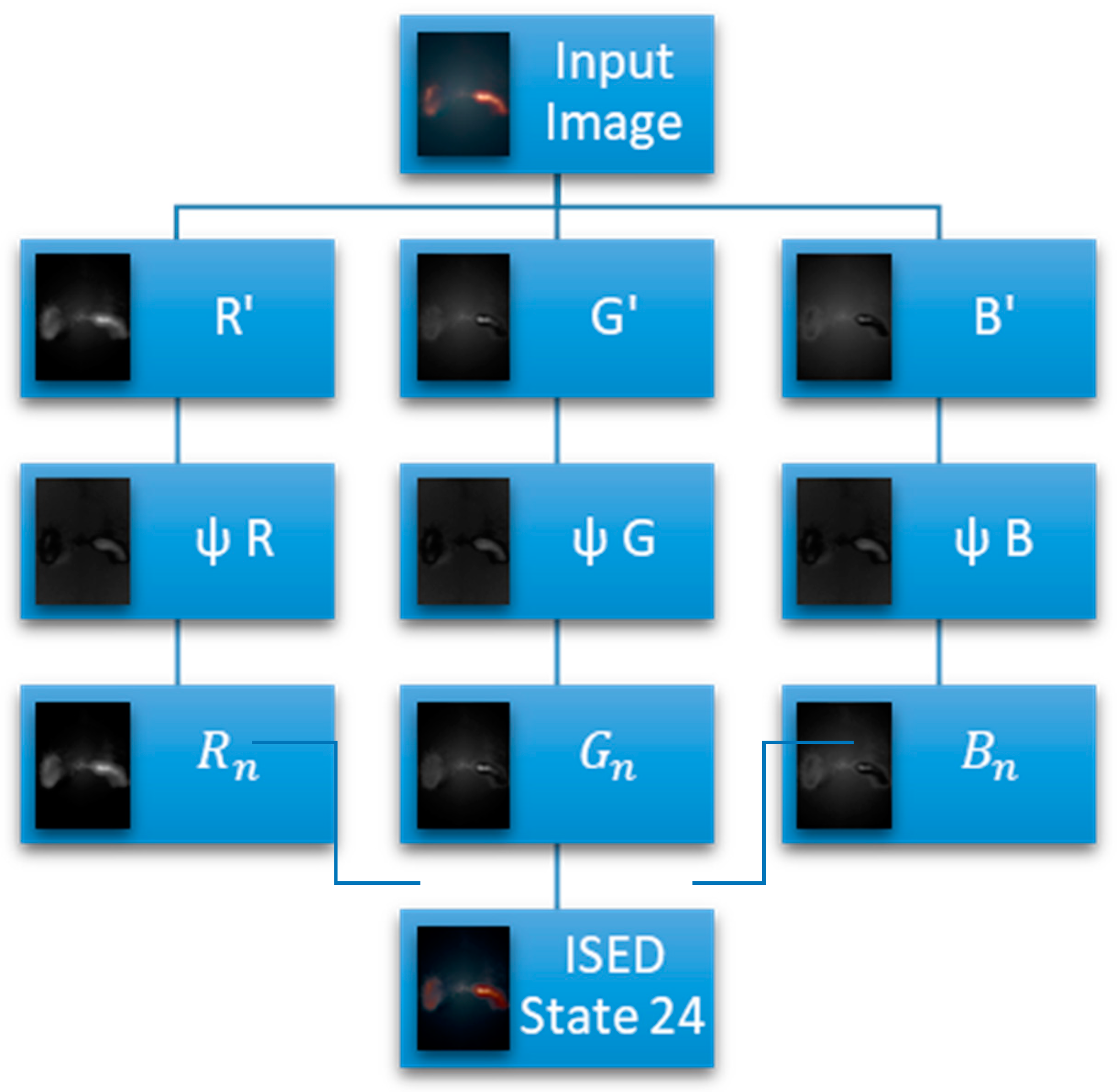

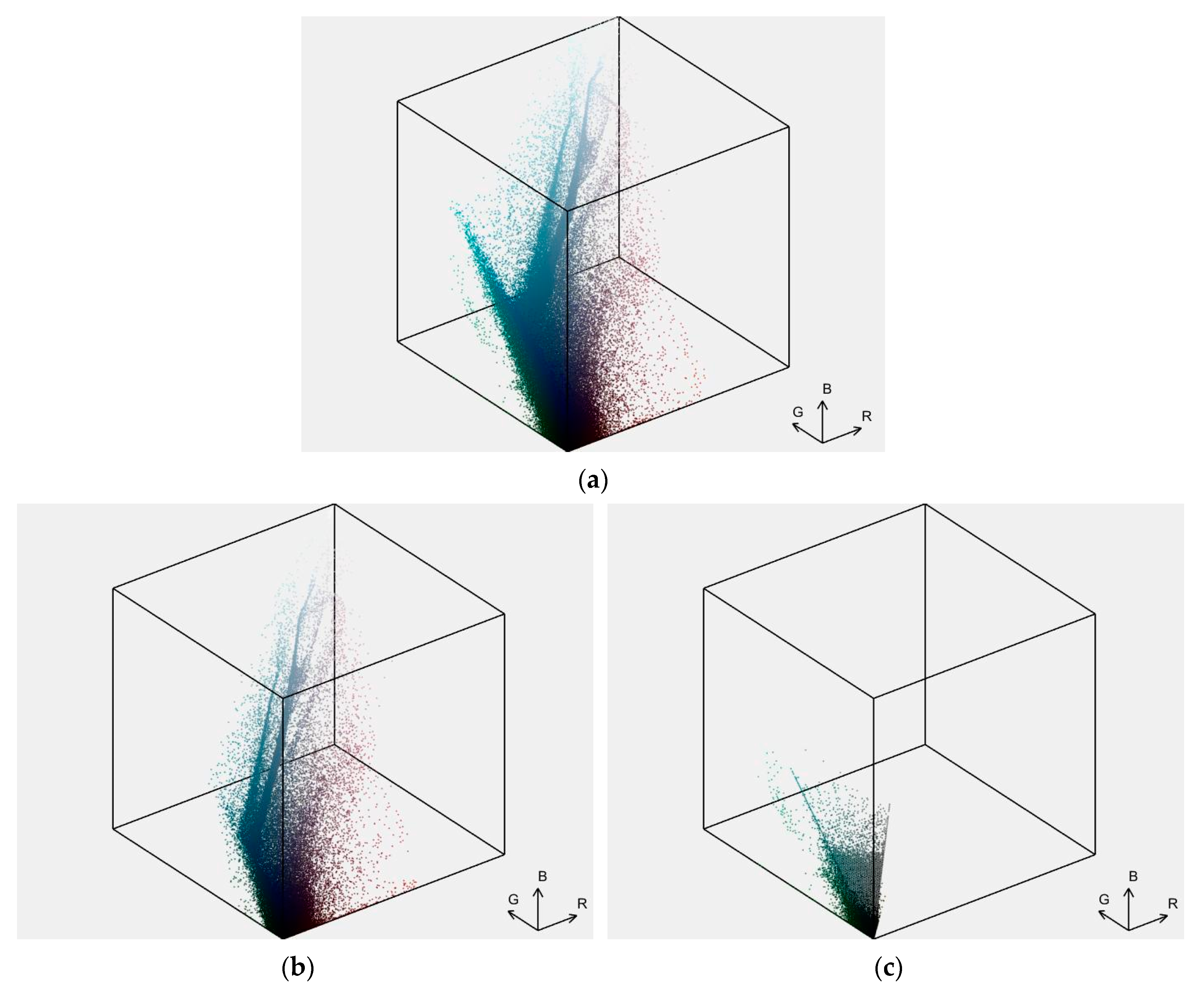




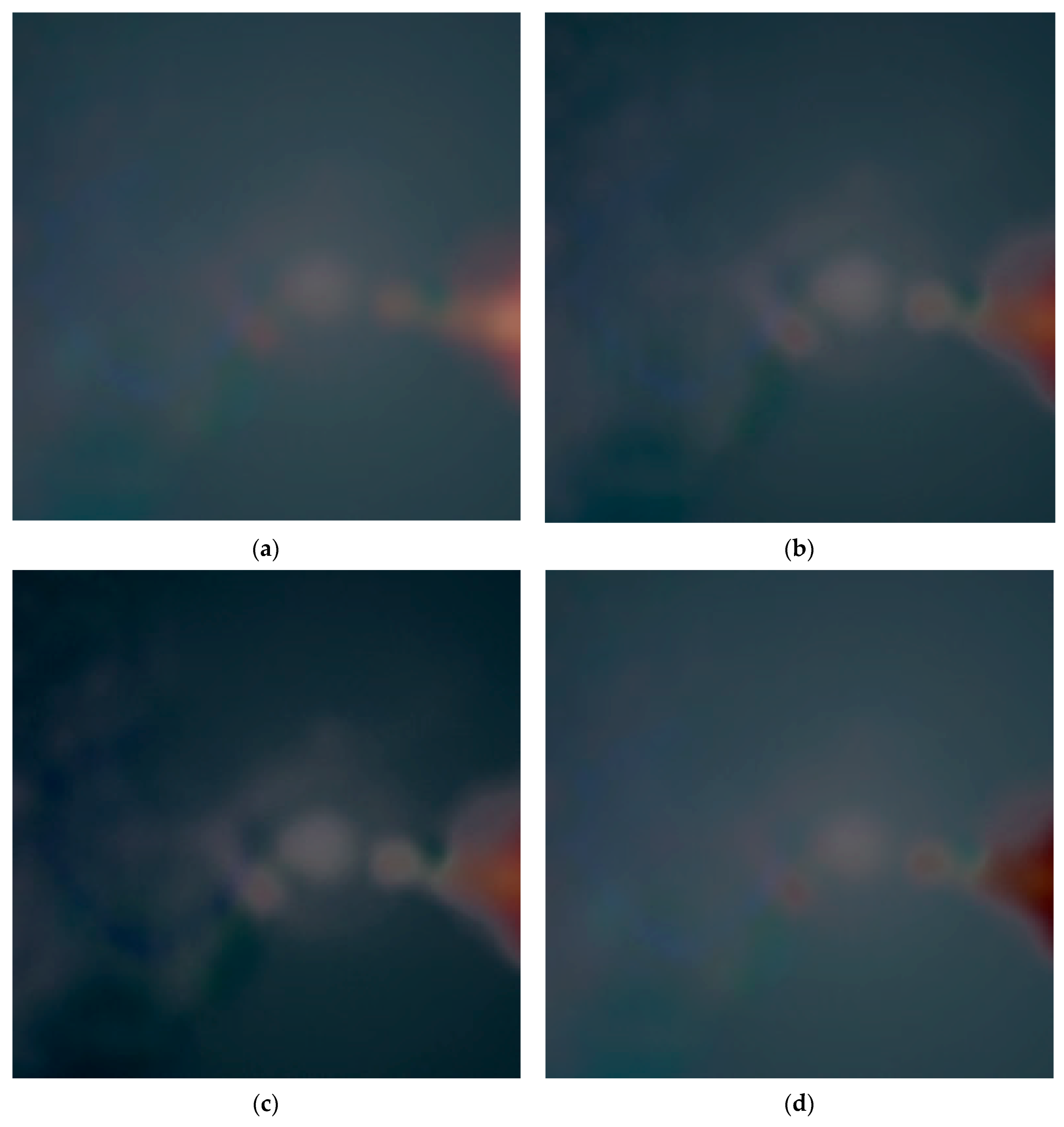


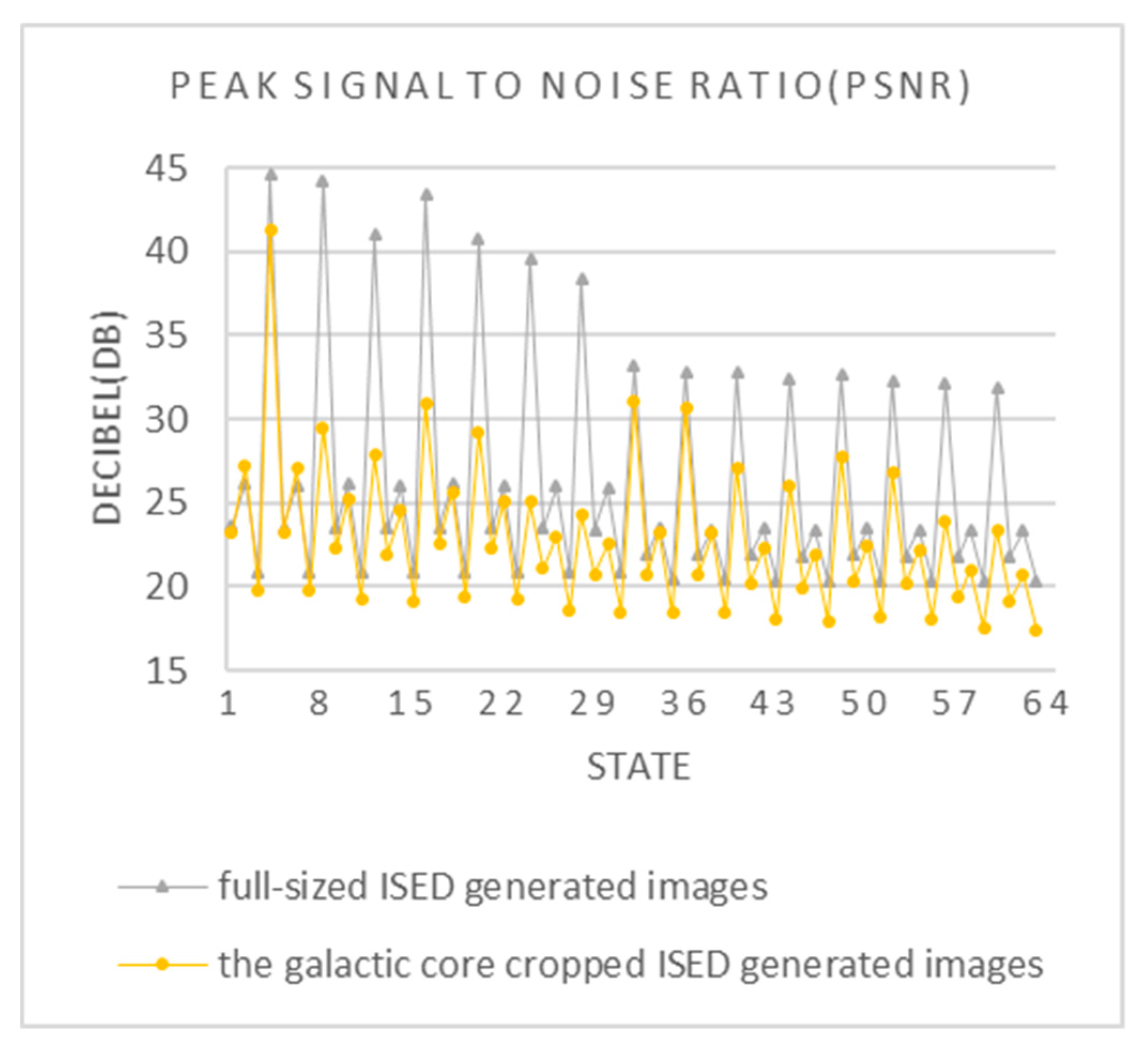
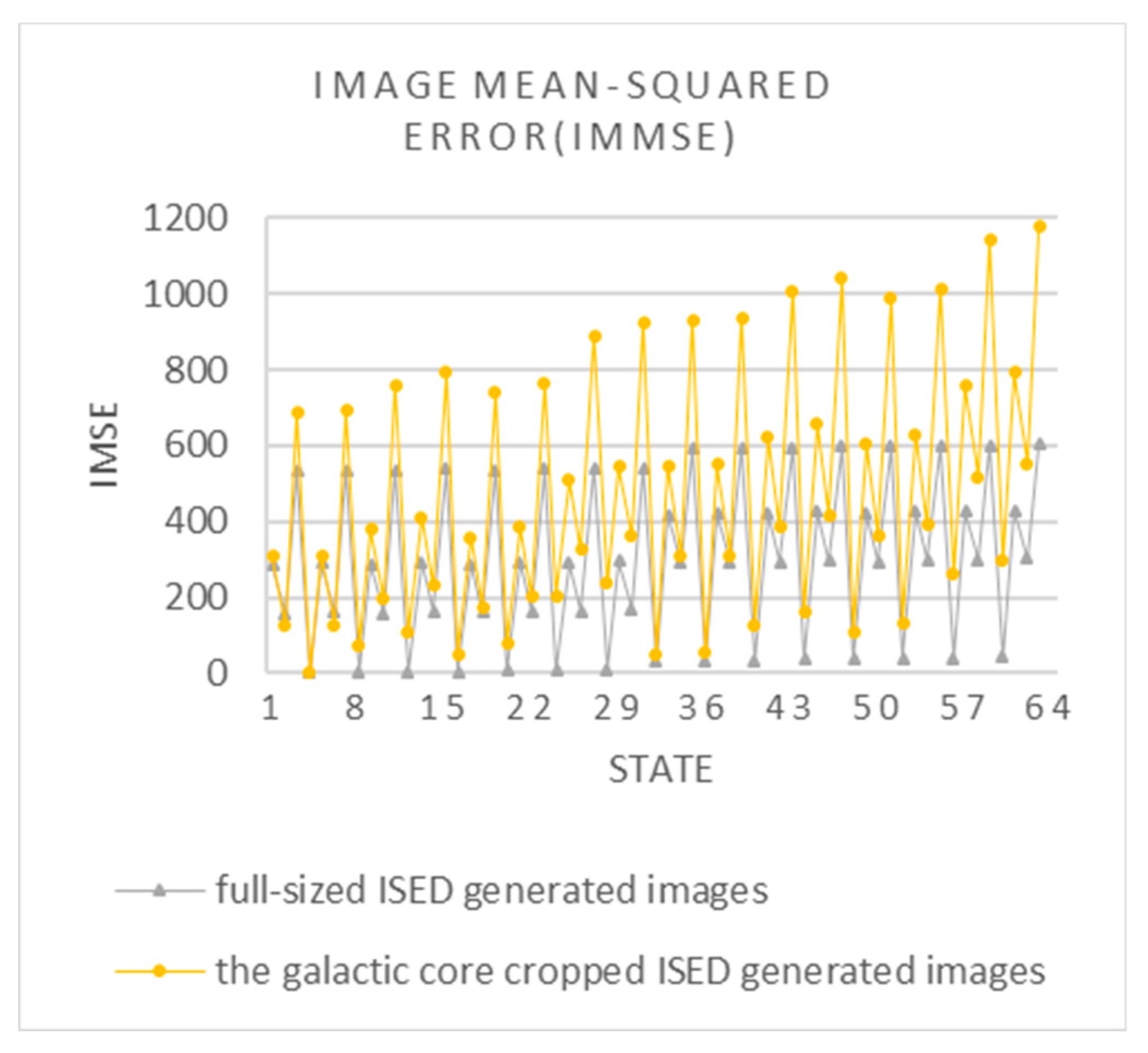
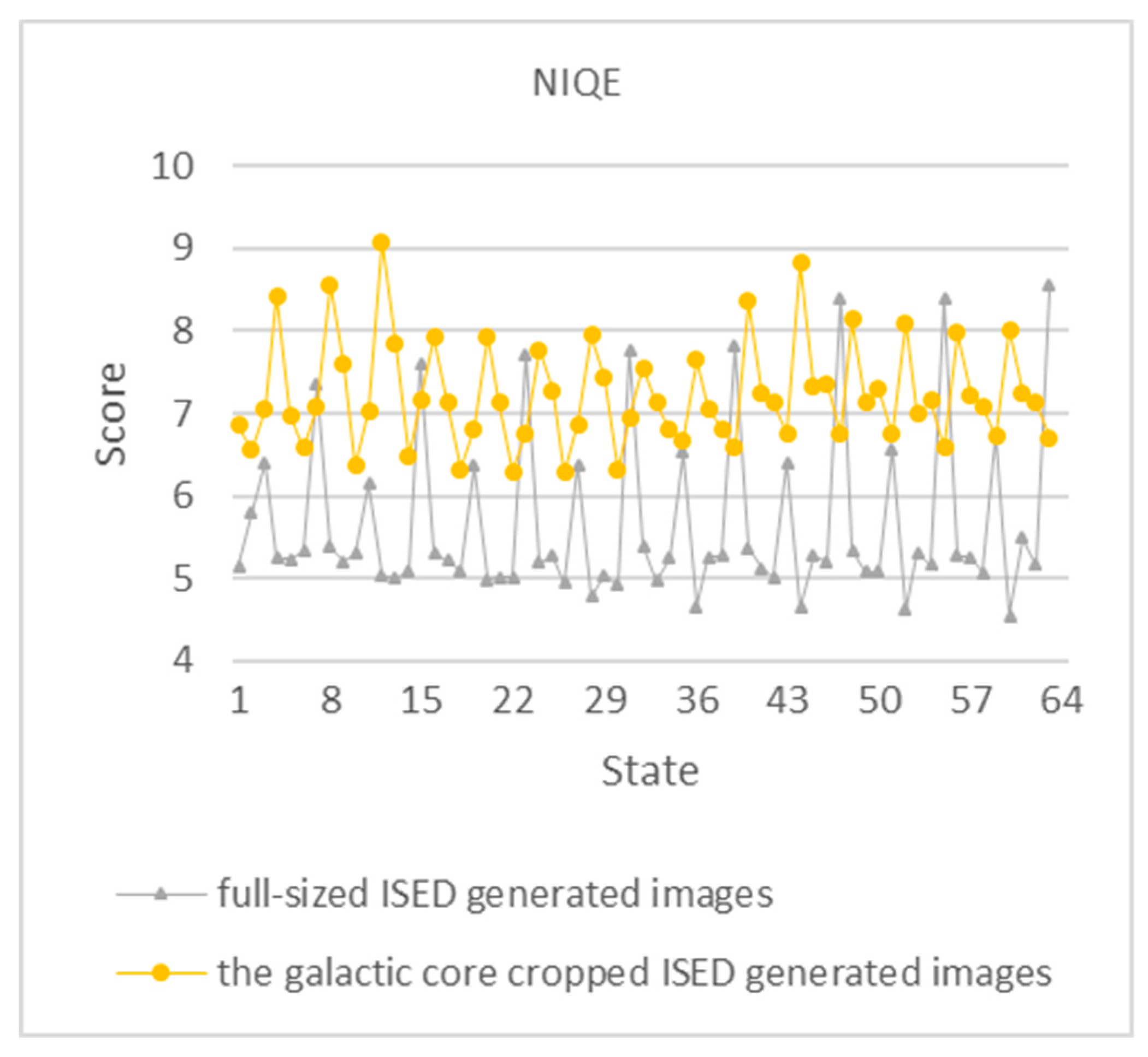


| Ensemble State | Balanced | ϕn | |||||
|---|---|---|---|---|---|---|---|
| Image | ψ1 | ψ2 | ψ3 | ψ4 | ψ5 | ψ6 | |
| Original image | (RGB)n | 0 | 0 | 0 | 0 | 0 | 0 |
| The 6th ISED | (RGB)n | 0 | 0 | 0 | 1 | 1 | 0 |
| Ensemble State | Balanced | ϕn | |||||
|---|---|---|---|---|---|---|---|
| Image | Switch | ψ1 | ψ2 | ψ3 | ψ4 | ψ5 | ψ6 |
| Original image | (RGB)n | 0 | 0 | 0 | 0 | 0 | 0 |
| The 22nd ISED | (RGB)n | 0 | 1 | 0 | 1 | 1 | 0 |
| The 23rd ISED | (RGB)n | 0 | 1 | 0 | 1 | 1 | 1 |
| The 24th ISED | (RGB)n | 0 | 1 | 1 | 0 | 0 | 0 |
| Compared Methods | Image Quality Assessment Metrics | |||||
|---|---|---|---|---|---|---|
| SSIM | PSNR | IMSE | NIQE | BRISQUE | PIQE | |
| M87 Full Original | NA | NA | NA | 5.54 | 43.56 | 57.37 |
| Average | 0.69 | 26.0 | 298.2 | 5.66 | 46.46 | 63.36 |
| M87 cropped | NA | NA | NA | 8.22 | 43.38 | 100.0 |
| Average | 0.70 | 22.8 | 473.1 | 7.22 | 42.90 | 46.23 |
| Quality Scale | Excellent | Good | Fair | Poor | Bad |
|---|---|---|---|---|---|
| Score range | [0,20] | [21,35] | [36,50] | [51,80] | [81,100] |
© 2020 by the authors. Licensee MDPI, Basel, Switzerland. This article is an open access article distributed under the terms and conditions of the Creative Commons Attribution (CC BY) license (http://creativecommons.org/licenses/by/4.0/).
Share and Cite
Taylor, T.R.; Chao, C.-T.; Chiou, J.-S. Novel Image State Ensemble Decomposition Method for M87 Imaging. Appl. Sci. 2020, 10, 1535. https://doi.org/10.3390/app10041535
Taylor TR, Chao C-T, Chiou J-S. Novel Image State Ensemble Decomposition Method for M87 Imaging. Applied Sciences. 2020; 10(4):1535. https://doi.org/10.3390/app10041535
Chicago/Turabian StyleTaylor, Timothy Ryan, Chun-Tang Chao, and Juing-Shian Chiou. 2020. "Novel Image State Ensemble Decomposition Method for M87 Imaging" Applied Sciences 10, no. 4: 1535. https://doi.org/10.3390/app10041535
APA StyleTaylor, T. R., Chao, C.-T., & Chiou, J.-S. (2020). Novel Image State Ensemble Decomposition Method for M87 Imaging. Applied Sciences, 10(4), 1535. https://doi.org/10.3390/app10041535






